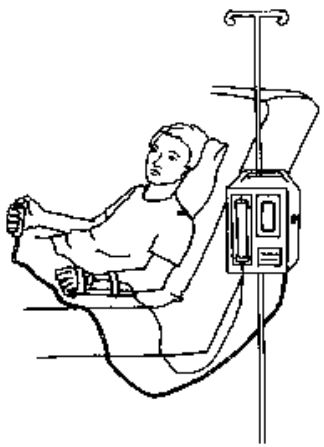Patient-controlled analgesia
What is patient-controlled analgesia (PCA)?
Analgesia means pain relief. Through the use of the PCA pump your child will be able to help control his or her own pain medicine. Studies have shown that children can be kept very comfortable when they control their own pain relief.
How does it work?
Your child will receive pain medicine through an IV connected to a machine called a PCA pump. Whenever feeling uncomfortable, your child can push a button and the pump gives more medicine. Children know how much pain they feel, and should be the only ones pushing the PCA button.
Depending on the amount of pain your child has, a small amount of medicine may also be given continuously. Your doctor will make the decision with input from your child, you, and the nurses.

How much medicine is given?
The pump will not give your child too much pain medicine. The doctor prescribes how much and how often your child can get a dose of medicine. Your nurse programs the pump as prescribed. The pump is locked while in use so the settings cannot accidentally be changed. Your child can receive medicine only as often as the doctor ordered it.
What are the side effects?
The most common side effect of pain medicine is drowsiness. Your child also may sleep more than usual because it is the body's way of healing itself. The nurse will check your child to see how easily he or she wakes up.
Other possible side effects are slow breathing, nausea (upset stomach), constipation, vomiting (throwing up), and itching. Medicines may be given to your child to help with these side effects. Your child will be on monitors so that the nurses can watch the breathing rate and oxygen saturation.
How can I help?
If your child seems to be hurting, you can remind him or her to push the button.
The nurses and doctors will talk to you and your child and check your child's comfort level. Because you know your child best, be sure to tell them if he or she seems uncomfortable to you. The doctor may need to change the medicine orders for the PCA.
Sometimes, family members and friends want to help by pushing the PCA button. This should be discussed with your doctor or nurse. Never push the button for your child, unless you are instructed to do so. Never push the button when your child is asleep.
You will probably notice that as each day passes, your child will be pushing the button less often. As soon as your child is able to eat, he or she will be able to take pain medicine by mouth.
Children's commitment to pain management
We believe babies, children, and teens have a right to the best level of pain relief that can be safely provided. Therefore, we take a team approach to pain and anxiety management, using drug and non-drug therapies. Our goal is to have staff and families work together to evaluate pain promptly and treat it effectively.
Questions?
This is not specific to your child, but provides general information. If you have any questions, please ask your child's doctor or nurse.
Children's Hospitals and Clinics of Minnesota
Last reviewed 8/2015
This page is not specific to your child, but provides general information on the topic above. If you have any questions, please call your clinic. For more reading material about this and other health topics, please call or visit Children's Minnesota Family Resource Center library, or visit www.childrensmn.org/educationmaterials.
© 2024 Children's Minnesota
